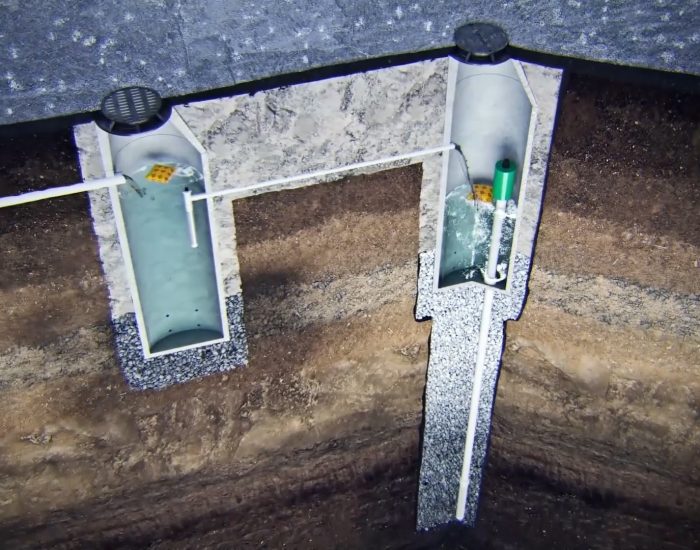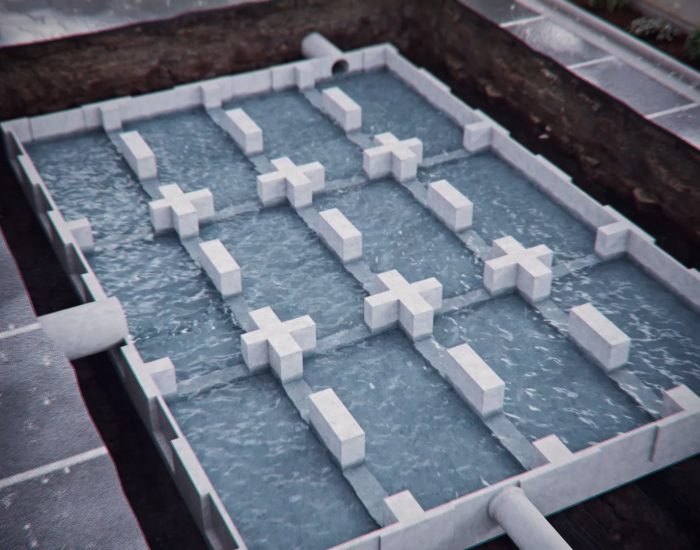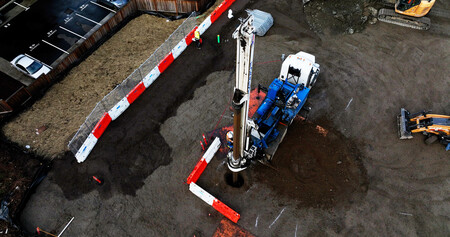

Replenish aquifers, mitigate flooding and meet regulations.
With increasing abstraction for potable and industrial use, our nation’s groundwater is under more and more pressure. Water scarcity is a critical issue, and many of our aquifers are under significant stress. At the same time, extreme weather events are becoming more frequent, and on the west coast and in our dry southwestern states flash flooding poses a significant risk to life and property. Artificial groundwater recharge techniques present an opportunity to replenish our aquifers and reduce the pressure on our nation’s water resources, drawing water away from the surface and infiltrating it where it’s most needed.
Our groundwater recharge solutions help engineers, architects, geotechnical professionals and contractors to plan, design, build and maintain stormwater management systems that replenish aquifers and protect homes, businesses and infrastructure from flooding.
Selecting a Groundwater Recharge Solution
Every site is different, and engineers, architects, and contractors must balance a range of factors to meet site-specific requirements and local regulations. The most important aspects to consider when designing and building a groundwater recharge system are:

Groundwater takes a long time to recharge via natural processes, with surface water taking decades or even centuries to reach deep-lying aquifers. Read more
Infiltration depth is dependent on the geology of the site, however, so when conducting site surveys geotechnical professionals should drill as deep as possible so that civil engineers understand the geological constraints and can design a system that infiltrates more effectively and more efficiently. Class V Underground Injection Control (UIC) wells are optimized for stormwater collection and may be used for deep infiltration.
On sites where deep infiltration is difficult or impossible, engineers may consider using shallow or surface-level infiltration techniques to ensure that stormwater enters the water table and can replenish the upper groundwater areas.
Product Applications

For sites that have to accommodate large volumes of surface water, storage volume is a critical factor. Not only does this help to move water away from the surface to reduce flood risk. Read more
This may be an attractive option to reduce abstraction at sites where deep infiltration is not possible but where water scarcity is nonetheless an issue.
Conversely, for sites that need to manage smaller volumes of stormwater, engineers may specify a more compact system that reduces land take and can be accommodated more easily within existing underground infrastructure.
Product Applications

When dealing with larger volumes of precipitation, collection systems can quickly become overwhelmed and fail to achieve effective infiltration, making drawdown speed a fundamental need. Read more
For sites that experience high rainfall or snowmelt, or that face increased risk of extreme weather events, engineers should opt for a system that collects surface water quickly.
This usually also requires moderate to high storage volumes, as infiltration is dependent on the geology of the site and infiltration speed will be much slower than collection speed.
Product Applications

Some development sites experience space constraints, whether because of existing subsurface infrastructure or geological features. Where this is the case, a collection and infiltration system with a larger surface footprint or underground volume may be impractical. Read more
Product Applications
Small / None
Moderate
Simplify Your Design Process

Your custom designs. Smarter. Faster. Easier.
Oldcastle Infrastructure’s suite of design tools streamlines your planning from concept to completion. Access user-friendly calculators, detailed product drawings, and specification tools that ensure accuracy, efficiency, and compliance, every step of the way.
Insights Articles & Case Studies
FAQ
What is artificial groundwater recharge?
While groundwater recharge occurs naturally, as precipitation enters the natural environment and percolates down into the vadose zone, it is a slow process and it is not always sufficient to recharge water at the same rate at which it is lost through abstraction.
Artificial groundwater recharge is the practice of using engineered systems and technologies to collect, store and infiltrate precipitation, increasing the amount of water that is returned to aquifers.
What artificial groundwater recharge techniques are there?
The key to effective groundwater recharge is in optimizing the collection, storage and infiltration rates of a site or catchment area.
To improve collection, civil engineers and architects may modify the landscape to direct rain or snowmelt towards collection points. Features such as canals and swales may be effective to direct surface water toward collection points.
Site characteristics along with municipal or state stormwater management requirements will determine what type of collection, storage and infiltration technique is most appropriate for a given project.
Surface infiltration provides high-amenity collection for low flows, while shallow infiltration may be used to collect large volumes of water and either infiltrate it at the top of the water table or reuse it for local irrigation. The most effective form of groundwater recharge is deep infiltration, which collects high volumes of water rapidly and infiltrates it at depths of up to 120ft.
What restrictions might groundwater recharge projects face?
Infiltration speed and depth are dependent on the geology of a site: the permeability of the geology determines the infiltration rate, while some sites may have impermeable geological features that prevent the implementation of deep infiltration. However, in some cases these geological features may be misleading—the layer of impermeable rock may be very thin—so it’s imperative that geotechnical professionals conduct surveys at sufficient depths to determine whether or not deep infiltration is achievable.
Another restriction that sites may face is existing subsurface infrastructure. For retrofit projects or developments within an already built environment, underground pipes and other features might place space constraints on a groundwater recharge system. In these cases, a narrow-diameter, small-footprint collection, storage and infiltration technology may be used to “thread the needle” and infiltrate at depth.
Are there any effective alternatives to groundwater recharge?
The objective of groundwater recharge is to return water to aquifers to replenish depleted water supplies, but in reality this is only one side of the equation; on the other side is the rate at which water is being taken from the aquifer.
While it may be difficult or impossible to reduce demand in absolute terms, there are things that we can do to improve the efficiency of water abstracted for human use.
We can improve efficiency and overall demand through implementing harvesting, recycling and reuse systems, for example, or by identifying and fixing the leaks that exist within our water infrastructure.
Where can groundwater recharge have the greatest benefit?
While aquifers are pressured across the US—due to drought and climate conditions, combined with increased abstraction and demand—states in the southwest and on the west coast are experiencing particular groundwater stresses.
Arizona, New Mexico, Texas, California, Oregon and Washington are all experiencing significant levels of groundwater depletion, so it is these states that can most benefit from implementing effective groundwater recharge systems and techniques.
What additional stormwater management objectives can groundwater recharge provide?
A key factor in effectively recharging groundwater is the collection and storage of surface water prior to infiltration. All groundwater recharge techniques, whether natural or engineered, involve transferring water from the surface into the water table.
An associated benefit of groundwater recharge, therefore, is in reducing the impact and minimizing the damage associated with flooding.
Engineered systems in particular may be designed with high drawdown speeds and large underground storage capacities, making them extremely effective at mitigating flood risk in areas with poor natural drainage, large areas of impermeable surfaces, or climates where extreme weather events are common.
Which Water Solutions Align With Your Project?
Get more information by filling out the quick form below.
Looking for a quote for your project?
While browsing our products, select “Add to Quote Generator” to quickly get an estimate for everything you need.
We use cookies to offer you a better browsing experience, analyze site traffic, personalize content, and serve targeted advertisements. Read about how we use cookies and how you can control them by visiting our Cookie Statement. If you continue to use this site, you consent to the use of cookies.








